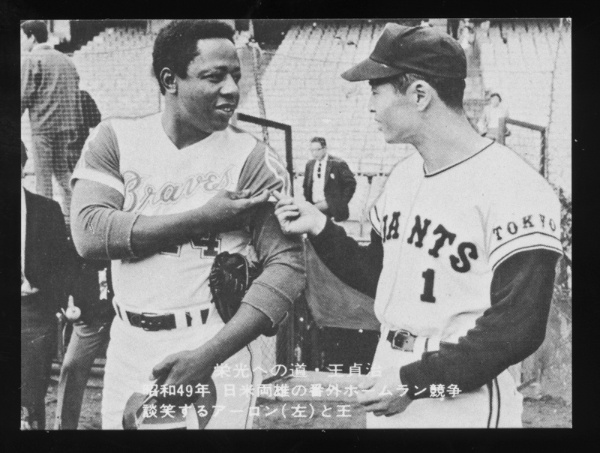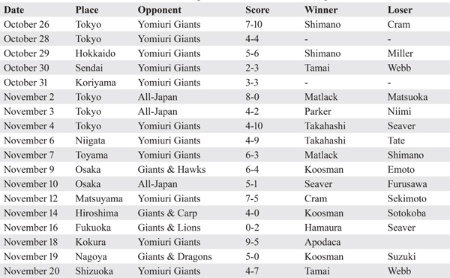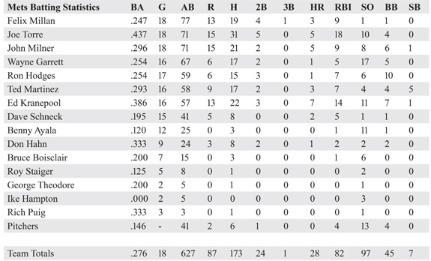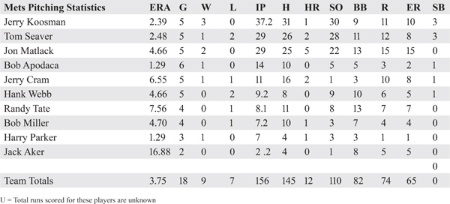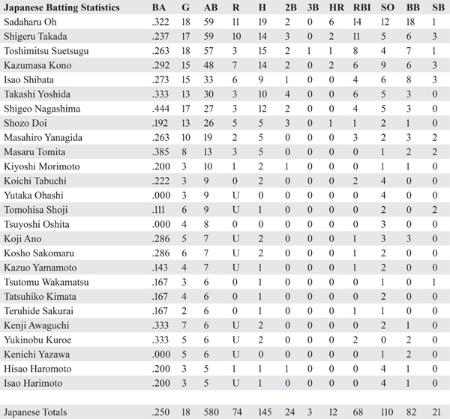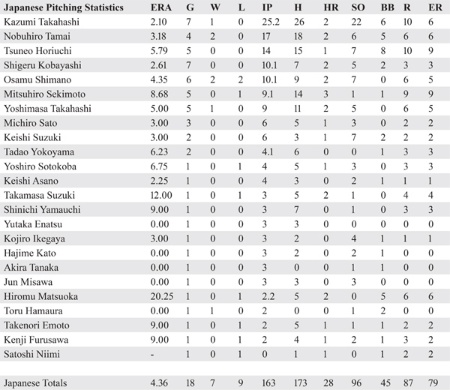The 1974 New York Mets Goodwill Tour of Japan
This article was written by Henry Tran
This article was published in Nichibei Yakyu: US Tours of Japan, 1960-2019
Calbee potato chip baseball card depicting Hank Aaron and Sadaharu Oh during their November 2, 1974 home run contest (Robert Fitts Collection)
For certain kids growing up in Tokyo in the 1970s, three of the most popular sports to watch on television were baseball, pro wrestling, and roller derby. For Hanshin fans, there was not much to cheer during the 1974 season, except for Koichi Tabuchi, the best offensive catcher in the league at that time, the Japanese equivalent of Johnny Bench. Some of the favorite wrestling moments were seeing Tiger Jeet Singh and Antonio Inoki going at each other or the Destroyer teaming with Giant Baba to face off against Fritz von Erich or Abdullah the Butcher. Then there was the Thursday night Roller Derby of the Tokyo Bombers against the New York Bombers or the LA T-Birds. Baseball, however, always took priority over the others. The one annoying thing was that the baseball TV broadcasts began at from 7 P.M., and at 9 P.M., whether the game was in the middle of excitement or a blowout, suddenly a woman’s voice offered this message: “Kono ban gumi wa goran no su pon sa no tei kyo de okuri shimasu” (“This program is brought to you by the following sponsors”) and the broadcast was over. That was when anyone wanting to know how the game ended had to listen to it on the radio.
The summer of 1974 had a treat for baseball fans: a US collegiate team visiting Japan for a series. Managed by the legendary Rod Dedeaux, the team was loaded with hitters. One of the highlights of the series was the game played at Meiji Jingu Stadium when pitcher Takashi Yamaguchi from Kansai University struck out 13 American batters in a 6-3 victory for Japan. Then an exciting Central League race between the Yomiuri Giants and the Chunichi Dragons made it a busy baseball summer. And Japanese fans were buzzing all summer long in anticipation of a visit by the New York Mets in November.
Hank Aaron ended the 1973 season with 713 career home runs, and second-year skipper Yogi Berra engineered the New York Mets to the NL pennant. Across the Pacific Ocean, Japan’s most popular team, the Giants, captured their 15th Japan Series, winning in five games over the Nankai Hawks. The baseball landscape in 1974 was heading into an exciting era. The Mets were invited to Japan for a goodwill tour at the conclusion of the season. With Aaron breaking Babe Ruth’s home-run record on April 8, 1974, Japan invited him over for a home-run contest with Sadaharu Oh. November could not come soon enough for Japanese fans. Despite the Mets’ disappointing season in 1974, which ended with a 71-91 record and a fifth-place finish in the National League East Division, Japanese fans were eager to see Berra, the Yankees’ former star catcher, and his All-Star pitcher, Tom Seaver.
On October 24 the Mets delegation arrived at Haneda International Airport in a chartered DC-8. As expected, the delegation was welcomed by hundreds of media members and fans.1 A lot of the fans remembered that Berra had come to Japan almost two decades earlier, in 1955, as a member of the Yankees. They were looking forward to seeing the Mets play 18 games in 12 cities. For different reasons, nine Mets players decided not to make the trip including Jerry Grote, Cleon Jones, George Stone, and Tug McGraw. Berra brought up Roy Staiger and Ike Hampton from Triple-A Tidewater. (Hampton later played a season for the Kintetsu Buffaloes.) The Mets also included on their roster Joe Torre, whom they had just acquired from St. Louis in exchange for Ray Sadecki and Tom Moore.
During the tour the Mets faced the Yomiuri Giants 10 times; the other eight games were split between an All-Japan team and squads of the Giants and another Nippon Professional Baseball Organization team.
Game 1: Mets vs. Giants
Korakuen Stadium, home of the Yomiuri Giants for almost 30 years, was located next to Korakuen Amusement Park. With a capacity of 50,000, it was the second largest ballpark in the JPL behind Koshien, home of the rival Hanshin Tigers, which could hold 60,0000. In a race decided by percentage points a few weeks before, the Giants lost the Central League pennant to the Dragons by a record of 71-50-9 (.5867) to 70-49-11 (.5882) – the closest winning margin ever. The postseason was an emotional time for Yomiuri, because the country’s favorite player, Shigeo “Mr. Giant” Nagashima, retired.2
On October 26, a capacity crowd filled the stadium to see the 1973 Cy Young Award winner, Tom Seaver, on the mound. Seaver pitched three innings, giving up three runs. The Mets jumped to a quick 3-0 lead off starter Mitsuhiro Sekimoto (10-5, 2.28 ERA during the season). With New York leading, 7-6, going into the bottom of the eighth inning, Oh parked a grand slam off reliever Jerry Cram and the Giants won, 10-7. John Milner, Wayne Garrett, and Dave Schneck all hit homers for the Mets. The Giants’ offense was impressive, recording 16 hits.3
Game 2: Mets vs. Giants
A crowd of 40,000 showed up for a Monday afternoon game at Korakuen. Jon Matlack was on the hill against Kazumi Takahashi. Matlack pitched four solid innings and the Mets led 4-2 on Don Hahn’s home run in the top of the fifth. However, as in Game 1, the Mets were not able to hang on to a lead, when reliever Jack Aker walked six runners to allow the Giants to tie the game in the bottom of the ninth. Shigeru Kobayashi and Osamu Shimano kept the Mets scoreless in the last five innings. Neither team scored in the 10th and the game was called a 4-4-tie. This was done mainly so the teams could catch a flight to Sapporo for Game 3 the next day. Mets manager Berra noticed that the Japanese style of play was more aggressive since his first visit in the 1950s. “They’ve improved a lot, they’re more aggressive now, they go for the hit-and-run play, and they bunt more,” he commented.4
Game 3: Mets vs. Giants
After an opening loss and a tie, the Mets were looking for a win in Sapporo. The teams arrived at Maruyama Stadium on October 29, a ballpark built in 1934 that seated 25,000. Occasionally the Giants and other teams played regular-season games at Maruyama. Jerry Koosman got the start. Before the game, Tom Seaver gathered seven Yomiuri pitchers in center field and gave advice about his four pitches and mechanics. New York Times writer Joseph Durso wrote: “They stood in a quiet semicircle on the center field grass in Maruyama Stadium beneath majestic mountains colored in the yellow and red of autumn. Expensive chalet homes snuggled into the slopes leading to the ski jump built for the 1972 Winter Olympics. In parkas and coats, the early arrivals began to crowd the gentle hill beyond the outfield fence at the foot of the mountain, spreading blankets on the cold ground to watch for the next four hours while the Giants and New York Mets brought their traveling goodwill tour north. Wood-burning heaters warmed the players in the dugouts and Sapporo beer warmed the customers who had paid $10 for box seats.”5
The Giants got to Koosman early, scoring two runs in the bottom of the second inning, but the Mets responded with two in the top of the third off starter Mitsuhiro Sekimoto. The Mets took the lead, 4-2, on a two-run single by Felix Millan in the fourth before Yomiuri recaptured the lead with three in the bottom of the fifth. The Mets got a run off reliever Takaaki Taniyama to tie the game at 5-5 in the sixth, but in the bottom of that inning, the Giants went ahead on a home run by Kazumasa Kono off reliever Bob Miller to win the game, 6-5. For the third straight game, the Mets did not hold on to their lead.6
Game 4: Mets vs. Giants
After the game the teams flew to Sendai, the capital city of Miyagi prefecture. As in Sapporo, there were no professional baseball teams in Sendai. The multipurpose Miyagi Athletic Stadium opened in 1952 with a capacity of 30,000: a mere 7,000 seats but standing room for 23,000. Tom Seaver faced off against Nobuhiro Tamai, pitched six innings and drove in a run in the top of the fifth. Ed Kranepool homered off Shigeru Kobayashi to tie the game at 2-2 in the top of the seventh, but reliever Hank Webb gave up the winning run in the bottom of the inning, making the final score 3-2. Yoshimasa Takahashi came in to save the game for the Giants in the top of the ninth. The Mets were winless in four tries.7
Game 5: Mets vs. Giants
The Mets arrived in Fukushima prefecture after a 90-minute ride on a bullet train. Kaiseizan Stadium had just opened in 1974 and was owned by Koriyama City. On this October 31 afternoon, with the temperature in the 40s, 18,000 fans flooded into the park to see Bob Apodaca start against Tadao Yokoyama.8 After seven innings, the Mets had a familiar 2-0 lead, with runs in the second inning on a fielder’s choice and an unearned run in the sixth. Once again the Mets were not able to hold on to their lead, as the Giants scored three runs in the bottom of the eighth inning, two of them on a double by Toshimitsu Suetsugu to put them in the lead, 3-2. The Mets came back in the top of the ninth with a solo home run by John Milner, his second in the series, and the two teams settled for another 3-3 tie. After five games against the Giants, the Mets were still winless.9
Game 6: Mets vs. All-Japan
The Mets were back to the familiar territory of Tokyo and Korakuen. A two-game series with the All-Stars was set for the weekend, in conjunction with Culture Day and the home-run contest between Hammerin’ Hank and Oh.
Aaron arrived at Haneda Airport on November 1 after a 17-hour flight from Atlanta and was thrust into a press conference at the Hotel Okura in Minato-ku with his rival, Japanese home-run king Oh. Aaron had completed the 1974 season with 733 home runs and Oh had 634. The two home-run heavyweights would take several rounds of swings to see who would wear the crown.10 Aaron had not swung at a ball since Atlanta’s last game of the season, against Cincinnati on October 2. In that game, he parked a homer off the Reds’ reliever Rawly Eastwick in the seventh inning, his 20th of the season.
Aaron and Oh were at the park taking batting practice at 10:30 A.M. The Mets and the All-Japan team were also there to prepare for their game after the home-run contest. Joe Pignatano, a coach for the Mets and a former catcher for the Dodgers, pitched to Aaron while batting practice pitcher Kuniyasu Mine threw to Oh.11 The 40-year-old Aaron was supposedly the underdog to the 34-year-old Oh, who had the home crowd of 50,000 behind him and was hitting against his familiar batting-practice pitcher.
Aaron suggested the rules for the contest: Each batter would swing at 20 balls and whoever put the most into the stands would win. Aaron was being paid $50,000 and Oh $20,000. Oh won the coin toss and elected to go first. There were four rounds of five pitches in each. In the first round, Oh put three balls (measuring 330 feet, 396 feet, and 412 feet) into the right-field stands. Aaron followed with 396-foot and 380-foot homers. After one round, Oh led 3-2. In the second round, Oh put three more into the stands, one of them almost 400 feet. Aaron put four over the wall to tie the score at 6-6 after two rounds. In the third round Oh managed only one rocket, and Aaron hit three to take the lead, 9-7. In the final round, Oh put two over, including a 400-footer, to tie it at 9-9. Aaron parked a 429-foot blast with his third swing to win the contest, 10 homers to 9.12
After the two kings met in person, Aaron expressed his humble feeling about the contest: “Oh is only 34, he has a chance to hit over 800. Winning today’s contest proves nothing. If there is any meaning, it is that we made the fans happy.” The fans were happy indeed: they were treated to a one-time event.13
The game followed the contest and the Mets were still looking for their first win. Southpaw Jon Matlack was assigned to go against the best hitters of NPB. Yakult Swallows’ ace pitcher Hiromu Matsuoka, who was 17-15 with a 2.80 ERA during the season, started for the All-Japan team. Matlack pitched beautifully, giving up just two hits in eight innings, while Matsuoka struggled with the Mets hitters, surrendering six runs in 2⅔ innings. The Mets’ Joe Torre, Ron Hodges, and Ted Martinez homered in an 8-0 victory over the All-Stars. The All-Stars included future Hall of Famers Isao Harimoto, Tsutomu Wakamatsu, Yutaka Fukumoto, Koichi Tabuchi, Oh, and Nagashima, but the Japanese media speculated that the All-Stars were not as good as the Giants, who had won their ninth straight championship in 1973.14
Game 7: Mets vs. All-Japan
The next day, November 3, the Mets and the All-Stars squared off again with Jerry Koosman on the mound against Keishi Asano, who went 12-15 with a 2.49 ERA during the season with the Yakult Swallows. The Mets trailed 2-1 going into the top of the ninth, but Felix Millan and Ed Kranepool homered to put New York ahead 4-2 (the eventual the final score) and give Harry Parker the win. The Mets’ pitching had held the best of NPB to two runs in 18 innings. Berra summarized in his own way: “It took us a week to catch up – the pitchers, at least. Hitters can usually hit – Aaron showed that Saturday in his home‐run contest against Oh. But pitchers can go stale, the way ours did.”15
Game 8: Mets vs. Giants
The Mets were playing their fourth straight game at Korakuen with another sellout crowd of 50,000 and looked for their first win against the Giants behind Tom Seaver. Yomiuri, wanting to continue its unbeaten streak, put Tsuneo Horiuchi on the mound. Seaver doubled in two runs to put the Mets up 3-1 in the top of the second but in the bottom of the inning, Shigeru Takada hit a three-run homer to put the Giants back on top, 4-3. John Milner hit a tying home run in the third; it would be the Mets’ last run of the game. Kazumasa Kono hit a solo homer in the bottom of the third to regain the lead and Oh added a solo homer in the sixth to make it a 6-4 game. Yomiuri then scored three runs on five hits, a walk, and two errors in the seventh and another in the eighth to win 10-4. In all, the Giants pounded out 17 hits, including three home runs.16
That evening, the Mets and Giants attended a reception at the US Embassy. Hank Aaron was also in attendance and the players from both teams exchanged game feedback as Shigeo Nagashima’s wife, Akiko, translated. Akiko had gone to Kokomo High School in Indiana and the College of St. Teresa in Winona, Minnesota.17
Game 9: Mets vs. Giants
After three nights in Tokyo, the Mets and Giants were off to Niigata City. The Niigata Athletic Stadium was built in 1936 and hosted the National Sports Festival in 1964. The stadium had 18,600 seats, but for the Mets-Giants matchup, 20,000 fans squeezed in. Randy Tate faced Mitsuhiro Sekimoto and was roughed up, allowing seven runs in 2⅓ innings. Tate walked six batters. Although the Mets offense retaliated with three runs, the Giants’ lead remained at 7-3 after three innings. Relievers Bob Apodaca and Harry Parker stopped the bleeding, but the Mets could not regain the lead. Dave Schneck and Joe Torre each hit their second home run of the series, and Ed Kranepool hit his third. New York lost 9-4 and was still unable to beat the Giants after seven games. After the game, the team got news from the front office in New York that reliever Jack Aker had been put on waivers. He was sent back to the United States.18
Game 10: Mets vs. Giants
The two teams arrived at Toyama City after a 3½-hour ride on the bullet train from Niigata. Jon Matlack got the start against Tsuneo Horiuchi in front of 20,000 fans at Toyama Municipal Stadium. Matlack pitched the Mets to their first victory over the Giants in eight tries. The Mets jumped on Horiuchi in the third inning, rallying for three runs, and took a 3-1 lead. The Giants responded and tied the game at 3-3 after five. The Mets took advantage of their hits against relievers Osamu Shimano and Kazumi Takahashi and scored three runs in the last four innings to gain the victory. Matlack shut out the Giants in the last four innings.19
Game 11: Mets vs. Giants-Nankai
When it came to the Nankai Hawks, Katsuya Nomura always stood in the picture. The Hall of Fame catcher had a career 657 home runs. From 1950 to 1974, the Hawks played in 10 Japan Series, the most of any team in the Pacific League’s 25-season history to that point. Nomura was the player-manager from 1970 to 1977, winning 512 games.20
In the matchup between the Mets and a combined Giants-Hawks squad on November 9, Jerry Koosman got the start against Takenori Emoto, the Hawks’ ace who produced a record of 13-12 with a 3.16 ERA during the season. The Mets jumped on Emoto with two runs after two innings including John Milner’s fourth home run of the series. In the top of the fifth, the Mets increased their lead to 5-1, scoring three runs off reliever Shinichi Yamauchi. Sadaharu Oh homered in the sixth and Mitsuru Fujiwara’s two-run double in the bottom of the eighth made it a one-run game, but Ed Kranepool hit a solo home run in the ninth to seal the 6-4 victory.21
Game 12: Mets vs. All-Japan
The Mets faced the All-Stars on November 10 for the third time and attempted to go 3-0. The Mets were also playing at historic Koshien Stadium for the first time on the tour. Koshien opened in 1924 and has been the home of the annual high-school tournament ever since, as well as the home ballpark of the Hanshin Tigers since 1936.
Tom Seaver took the mound against the All-Stars against Yutaka Enatsu of the hometown Hanshin Tigers. Seaver fanned 11 batters in a complete game. With the Mets down 1-0 going into the top of the fifth, Ted Martinez hit a three-run home run off reliever Kenji Furusawa of the Tigers to put the Mets up, 3-1. Then in the top of the seventh, Milner sent another souvenir ball to the fans in the left-field stands for a two-run round-tripper. The 5-1 victory over the All-Stars gave the Mets a three-game sweep. More impressive was the pitching, which allowed the All-Stars only three runs in the three games.22
Game 13: Mets vs. Giants
The teams headed to Matsuyama City on the island of Shikoku, where they squared off against the Giants at Matsuyama Municipal Baseball Field. Jon Matlack started on the hill against Tsuneo Horiuchi. Yomiuri quickly ran up five runs against Matlack after three innings, including a two-run homer by Oh in the third. Kranepool responded with a two-run home run in the top of the fourth to cut the deficit to 5-2. Relievers Apodaca and Parker shut down the Giants offense as the Mets continued to chip away. In the eighth the Mets scored twice on two singles, an error, and a wild pitch to cut the deficit to 5-4. After two outs in the ninth, Milner and Joe Torre singled to bring up Kranepool, who homered off Mitsuhiro Sekimoto to put the Mets ahead 7-5. Jerry Cram shut down the Giants in the bottom of the ninth to secure the victory.23
Game 14: Mets vs. Giants-Hiroshima
The opening of the Hiroshima Municipal Stadium in 1957 with 32,000 seats to replace the old 13,000-seat Hiroshima Sogo Ground Baseball Park, initiated an exciting era for the Carp baseball team. The Mets and Giants traveled across the Seto inland sea from Matsuyama to Hiroshima for the 14th game of the tour. In Hiroshima, the Giants teamed with the Carp to take on the Mets. The Carp had not had a good year, finishing in sixth place in the Central League. Their bright spots were future Hall of Famers Sachio Kinugasa, who hit 32 home runs, and Koji Yamamoto, who hit 28. Jerry Koosman took the mound for the Mets and went the distance in a 4-0 Mets victory in front of 22,000 fans. Joe Torre hit his third home run of the tour in the fourth inning off rookie Kojiro Ikegaya (who became the Carp’s ace the next season, going 18-11 with a 3.32 ERA), and that was all the Mets needed to clinch the victory. The Mets added another run off reliever Sohachi Aniya in the top of the sixth inning.24
Game 15: Mets vs. Giants-Lions
Heiwadai Stadium in Fukuoka opened in 1949 and was home to the Lions. Although the team had multiple owners (Nishitetsu, Taiheiyo Club, and Crown Lighter), the name Lions was preserved, and they remained in the same ballpark until 1978. The Lions were Pacific League champions in 1954 and 1963 and won the Nippon Series in 1956, 1957, and 1958. Once they became the Seibu Lions in 1979 and moved to Tokorozawa in Saitama Prefecture, the team dominated the Pacific League during the 1980s and ’90s.
On November 16, a combination of Giants-Lions were the Mets’ opponents. Up to this point, the Mets had defeated every combination team and all-star team. Tom Seaver took the mound against Taiheiyo Club starter Hajime Kato, who had a 12-12 record during the ’74 season with a 2.95 ERA. Seaver threw a complete game but gave up two runs in the bottom of the eighth and the combined team blanked the Mets 2-0 in front of a capacity crowd of 32,000. Akira Tanaka, the Lions’ ace reliever, who pitched in 50 games with a 12-5 record and 2.61 ERA, relieved Kato in the fourth and pitched three no-hit innings before Toru Hamaura took over and added two more no-hit innings. Osamu Higashio closed out the game with a no-hit ninth. It was a fast-moving game: 1 hour and 51 minutes.25
Game 16: Mets vs. Giants
Getting down to the end of the trip, the Mets arrived at Kokura on the most northern point of the southern island of Kyushu. The teams played on November 18 at Kokura Stadium which had a capacity of 20,000. The crowd of 12,000 showing up on this Sunday afternoon was treated to two home runs by Sadaharu Oh, his fifth and sixth against the Mets. Shozo Doi, who did not hit a home run during the season, hit one over the fence. Doi was a product of Rikkyo University, the alma mater of Nagashima. The Mets started Jon Matlack against Tsuneo Horiuchi. Matlack gave up five runs in five innings, but the relievers Hank Webb and Bob Apodaca shut out the Giants in the last four innings. Horiuchi allowed two runs in two innings and relievers Kazumi Takahashi and Shigeru Kobayashi gave up a run each, allowing the Mets to trail by only one run, 5-4, going into the top of the ninth. Leadoff batter Felix Millan began by sending an Osamu Shimano pitch into the left-field stands to tie the game. Milner and Torre then singled, and Milner scored on Kranepool’s fly out to put the Mets ahead. Next, Ted Martinez broke the game open with a two-run homer. New York added a final run on doubles by Don Hahn and Ron Hodges to win 9-5. It was the Mets’ third victory against the Giants in 10 tries.26
Game 17: Mets vs. Giants-Chunichi
The Mets traveled back to Honshu Island and faced a combined Giants-Dragons team at Chunichi Stadium in Nagoya on November 19. The Chunichi Dragons were the Central League champions, managed by Hawaiian native Wally Yonamine. Yonamine’s story was like a fairy tale. He was the first person of Japanese descent to play professional football, appearing with the San Francisco 49ers after World War II, and the first American to play professional baseball in postwar Japan. Before joining the Dragons as a coach and later manager, he led Yomiuri to the Nippon Series championship four times, was the league MVP in 1957, made the All-Star team eight times, and the Best Nine seven times. Yonamine was inducted into the Japanese Baseball Hall of Fame in 1994.
Jerry Koosman allowed just four hits as he shut out the Giants-Dragons, 3-0. Japanese starter Takamasa Suzuki was charged with four runs in three innings with home runs by Ed Kranepool and Felix Millan. He was relieved by Jun Misawa, the Dragons’ number-3 pitcher with an 11-9 record and 3.45 ERA during the season. Joe Torre hit a solo homer in the top of the eighth off reliever Mitsuo Inaba of the Dragons.27
Game 18: Mets vs. Giants
The Mets and Giants headed to Shizuoka City for the finale of the Goodwill Series. Kusanagi Stadium was opened in 1930 and could hold 30,000 fans. Outside the ballpark stand statues of Eiji Sawamura and Babe Ruth. The ballpark was packed as Mets starter Randy Tate squared off against Nobuhiro Tamai. After four innings, the score was 0-0, then the Mets exploded with four runs in the top of the fifth, including a home run from Joe Torre, his fifth of the series. In the bottom of the fifth, the Giants responded with seven runs on seven hits and three walks as they sent 13 batters to the plate against relivers Hank Webb and Bob Apodaca. Giants ace Tsuneo Horiuchi came in the top of the seventh and pitched three scoreless innings to save the game as Yomiuri defeated the Mets, 7-4, to wrap up the tour.28 After the game, Giants manager Testuharu Kawakami announced his retirement after 14 seasons at the helm. During his tenure he led the Giants to 11 Japan Series championships.29
Conclusion
The Mets ended with a record of 3-6-2 against the Giants, starting out 0-5-2 before winning three of the last four games. They were 3-0 against All-Japan, and 3-1 against a combination of Giants with another team. The Mets hit 28 home runs, while the Giants hit 11. In the seven combination or All-Japan games, there was only one Japanese home run, by Sadaharu Oh. Oh hit .322 with six home runs against the Mets.
Shigeo “Mr. Giant” Nagashima, who retired at the end of the season, played in all but one of the games against the Mets and batted .444 for the series. This was the last time he was on the diamond as a player. The next season, he took over Kawakami’s position as the Giants’ manager.
Joe Torre said of the Japanese players, “[T]hey were good, well disciplined, they continue to be well disciplined, but as far as being major league caliber players, there were just a few.”30 Torre did not waste time impressing his new team during the tour, hitting .437 with five home runs. John Milner also hit five homers and Ed Kranepool led the Mets with seven.
Tom Seaver pitched well with a 2.48 ERA in five starts. His most impressive performance came against the All-Japan team on November 10 when he went the distance and allowed only one run. Jerry Koosman had the best record, going 3-0 with a 2.39 ERA in four starts.
The 1974 season was memorable for baseball fans in the Tokyo area. Waseda University won the All-Japan University Baseball Championships. Choshi Shogyo won the Summer Koshien High School Tournament. There was an exciting US-Japan Collegiate Championship series that previewed several future major leaguers. The Chofu Little League team won the All-Japan Championships and advanced to the Far East Regionals and was one win from going to the Little League World Series.31 Wally Yonamine got his due by winning the pennant for the Dragons. And the year concluded with Hank Aaron and Sadaharu Oh slugging it out in a home-run contest and the Mets’ goodwill tour, which provided some great memories.
HENRY TRAN lived in Tokyo as a child admiring the game of baseball. Although he lived only five train stations from Korakuen Stadium, home of the Kyojin, he developed a following of the Hanshin Tigers. His favorite childhood player was the Tigers’ slugging catcher, Koichi Tabuchi. Henry is a college professor who also coached high-school and junior college basketball for 25 years. He has published three sports books: They Still Call Me Coach (his basketball coaching life), The Orient Sports Express (honoring Asian-American athletes), and 1995 (the Cal State Fullerton baseball story). It is an honor for Henry to share his experience of Japanese baseball and the Mets’ Goodwill visitation in 1974 and being part of this historical book.
1974 New York Mets Games in Japan (9 Wins, 7 Losses, 2 Ties)
(Click images to enlarge)
Notes
1 Joseph Durso, “Warm Tokyo Welcome Starts Met Orientation,” New York Times, October 25, 1974: 45.
2 Wayne Graczyk, “Legend Nagashima Rekindles Memories of an Unforgettable Life in Baseball,” Japan Times, February 25, 2017. https://www.japantimes.co.jp/sports/2017/02/25/baseball/legend-nagashima-rekindles-memories-unforgettable-life-baseball/.
3 Joseph Durso, “Tom Terrific and Mr. Oh,” New York Times, October 27, 1974: 229.
4 Joseph Durso, “Another Diplomatic Success,” New York Times, October 29, 1974: 45.
5 Joseph Durso, “How to Pitch in Sapporo,” New York Times, November 1, 1974: 45.
6 Associated Press, “Japanese Beat Mets Again on Homer,” New York Times, October 30, 1974: 54.
7 Associated Press, “Yomiuri Giants Beat Mets Again, 3-2,” New York Times, October 31, 1974: 59.
8 Associated Press, “Mets Tie on Milner’s Homer,” New York Times, November 1, 1974: 46.
9 “Milner HR Helps Mets Tie Giants,” Pacific Stars and Stripes, November 2, 1974: 20.
10 Ken George, “Hank Aaron in Japan,” Stars and Stripes, January 23, 2021, https://www.stripes.com/history/archive_photo_of_the_day/hank-aaron-in-japan-1984-1.659530.
11 Associated Press, “Aaron Wins Home Run Match, 10-9,” New York Times, November 2, 1974: 19-20.
12 Associated Press, “Aaron Wins Home Run Match, 10-9”; Joe Guzzardi, “In 1974, Aaron and Oh Slugged It Out – Who Won?” Lodi (California) News, March 31, 2012. https://www.lodinews.com/opinion/columnists/joe_guzzardi/article_3be45fb2-2eb8-53f6-820b-027fdf470c48.html.
13 Yoichi Nagata, “The Oh-Aaron Home Run Duel,” BaseballGuru.com. http://baseballguru.com/jholway/analysisjholway35.html.
14 Joseph Durso, “Mets, Good Diplomats, Lose Again,” New York Times, November 5, 1974: 43, 46.
15 Durso, “Mets, Good Diplomats, Lose Again.”
16 “Giants Rout Mets 10-4 With 3 Homers, 17 Hits,” Japan Times, November 5, 1974: 8.
17 Durso, “Mets, Good Diplomats, Lose Again”; John Dempsey, “‘61 KHS Grad Dies in Japan,” Kokomo Tribune, September 20, 2007. https://www.kokomotribune.com/news/local_news/61-khs-grad-dies-in-japan/article_df29ef6b-a30c-52f4-8490-55cb1cb78db6.html.
18 Associated Press, “Mets Lose Again; Aker Waived,” New York Times, November 7, 1974: 65.
19 Associated Press, “Mets Finally Beat Yomiuri Giants,” New York Times, November 8, 1974: 34.
20 Robert Whiting, “Katsuya Nomura, Star Baseball Player with Rocky Personal Life,” Nikkei Asia, February 14, 2020. https://asia.nikkei.com/Life-Arts/Obituaries/Katsuya-Nomura-star-baseball-player-with-rocky-personal-life.
21 Associated Press, “Met Homers Turn Back Japanese,” New York Times, November 10, 1974: 263.
22 Associated Press, “Mets Win on Seaver’s 4-Hitter,” New York Times, November 11, 1974: 36; United Press International, “Mets Beat All-Japan Team,” Japan Times, November 12, 1974: 8.
23 United Press International, “Mets Score Second Win Over Giants 7-5,” Japan Times, November 13, 1974: 11; Associated Press, “Mets Win and Go Over .500,” New York Times, November 13, 1974: 55.
24 Associated Press, “Mets Begin to Win in the East,” New York Times, November 15, 1974: 42.
25 Associated Press, “Mets Set Again in the East,” New York Times, November 17, 1974: 268.
26 United Press International, “Oh Hits 2 HRs; Giants Bow to Mets Rally in 9th 9-5,” Japan Times, November 19, 1974: 9; Associated Press, “Mets Beat Yomiuri Giants,” New York Times, November 19, 1974: 59.
27 “Koosman 4-Hit Shutout Stops Giants-Dragons,” Japan Times, November 20, 1974: 8.
28 Associated Press, “Sayonara for Mets with 9-7-2 Mark,” New York Times, November 21, 1974: 67.
29 “Kawakami Retires as Giants’ Pilot,” Japan Times, November 21, 1974: 6.
30 “Winter Meeting Interview with Joe Torre,” MLB.Com. https://www.mlb.com/news/winter-meetings-interview-with-joe-torre/c-40506326.
31 Baseball Reference, “All-Japan University Baseball Championship Series,” https://www.baseball-reference.com/bullpen/All-Japan_University_Baseball_Championship_Series; Baseball Reference, “National High School Baseball Championship Series,” https://www.baseball-reference.com/bullpen/National_High_School_Baseball_Championship.
32 Listed Japanese players have a minimum of 5 at-bats, 3 innings pitched, or a decision. Yoshikazu Matsubayashi, Baseball Game History: Japan vs, U.S.A. (Tokyo: Baseball Magazine, 2004), 100; Nippon Professional Baseball Records, https://www.2689web.com/nb.html.


